This is the 11th month of the world wind Cheesepalooza challenge and there is only 1 more month to go after. I know I said the same thing last month but, oops, I had missed the 12th challenge. The finale next month will be…interesting and creative to say the least. But for this month we had to make a blue cheese.
I have been looking forward to making blue cheese since day one. It is a cheese I hated as a child but have grown to adore. My particular favorite is called a Bleu d’Auverge, from the same named region in France. I came across a recipe for a Fourme d’Ambert also from the Auvergne Region.

The word fourme is derived from the word forma, meaning shape. And the word for cheese in French is fromage. The share the same Latin root. Fourme d’Ambert and dates to the Druids and the Gauls during Roman times. It is one of France’s oldest cheese.
This is one the the mildest blue cheeses. The texture is beyond creamy and delicious. Subtle flavors of fruits, chocolate, tobacco, nuts and mushroom dance on the tongue at every bite. The inside is very pale and lines of blue traverse the cheese where the skewer went through.

To eat or not to eat the crust: that is the question! I have been debating this very quote for weeks! I read a normal blue cheese does not make a crust. When the cheese is ripe the mold is wiped off. So when a natural rind resembling rough stone formed I was not sure what to do. It was not in any recipe I read. But I did some research on other similar cheeses and the answer seemed to be a resounding YES. That was an excellent decision. Once cut the crust was a lot thinner than I expected and the flavor was mild, just like a Camembert.
Making a blue cheese the first time is terrifying. Blue fuzzy foods normally go in the trash! But for a blue cheese it is desired. Over the weeks the transformation is fascinating and scary. Is it doing what it is suppose to? When the day came to taste the cheese my fear vanished. I knew this was the crowning jewel of all my handmade cheeses. I really could have eaten all in one shot. I did not and let several people try it. Everyone was amazed and said it looked like a real French artisan cheese.
The Fourme d’Ambert freshly pressed on the right, next to the beer brined Ale Washed Trappist Cheese.
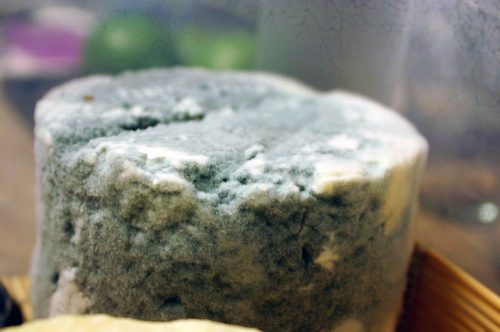
A fresh coating of blue fuzz Penicillium roqueforti. This is the most obvious proof that cheese is a living thing!
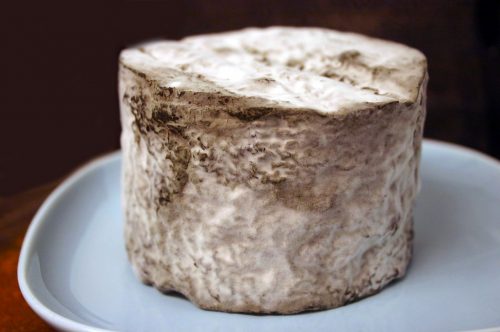
A month into the aging process. The cheese is all covered with a white fuzz on top.
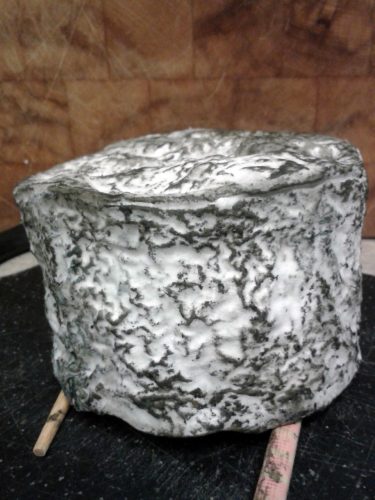
The finished cheese after 7 weeks. Shriveled up and black with a white powder. Gold, just like a truffle.
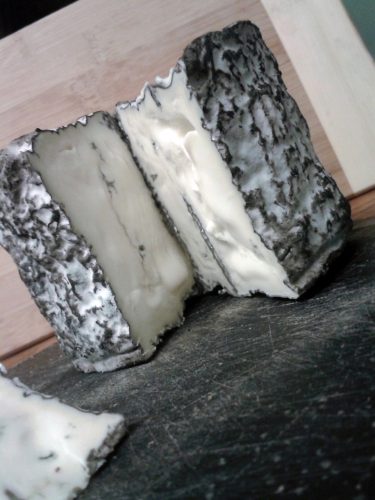
See how creamy the inside is, gravity struggling to let the inside ooze out into a creamy flow.
If you want to see the whole process of making cheese, from flocculation to cutting the curd and releasing the whey, check out my earlier post.
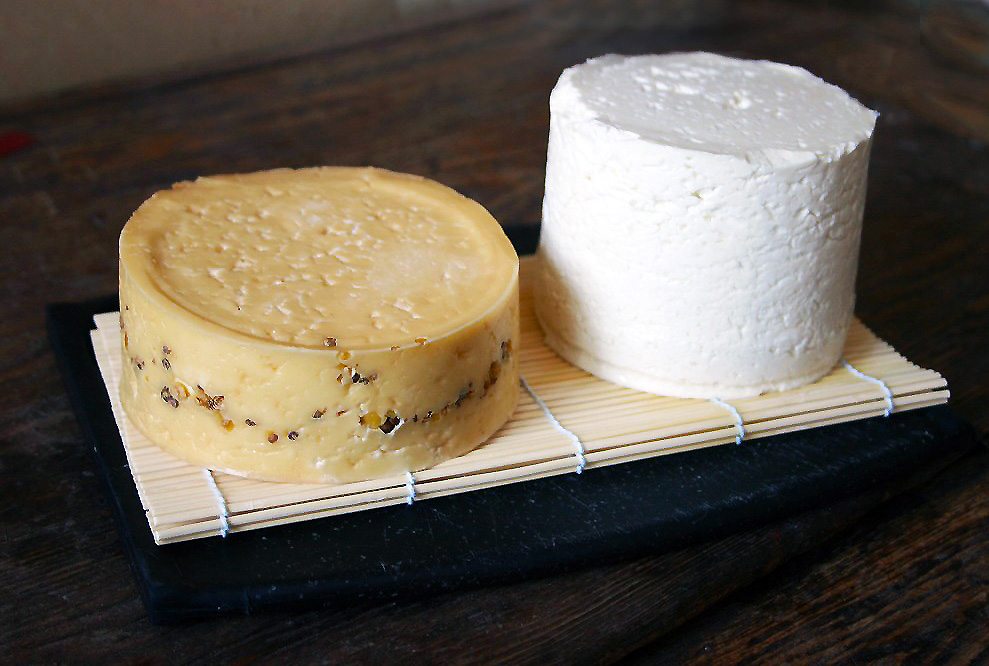
Fourme d’Ambert Cheese
Ingredients
- 2 gallon whole milk
- 1/2 cup heavy cream
- 1/4 th tsp. mesophilic culture
- 1/16 th tsp. Penicillium roqueforti
- 3/8 th tsp. calcium chloride
- 1/4 th tsp. rennet
- 1 pound cheese salt
- ½ tablespoon calcium chloride
- ½ teaspoon vinegar
Instructions
- Heat milk to 90°F, stir in cultures. Let ripen, maintaining temperature, for an hour.
- Stir in calcium chloride and then rennet for 30 seconds.
- Leave for 90 minutess until the curds give a clean break before cutting.
- Cut curds to ½ inch and stir.
- Maintain 90°F, occasionally stirring gently for 1 hour until curds are small and firm.
- Remove whey down to surface of curds, reserving 1/2 gallon whey for brine.
- Ladle curds into a prepared sterilized mold.
- Once all curds are in the mold, press on light pressure for 1 hour, redress, and press for 8 additional hours on light pressure.
- After pressing, remove the cheese from the mold
- Make brine with reserved whey and 1 pound of cheese salt stirred until dissolved. Mix in calcium chloride and vinegar.
- Brine it for 4 hours, flip it, and brine for 4 more hours.
- Dry the cheese on plastic mats in a plastic tub with the lid partially open to allow some drying off of the cheese, and store at 75F for 24 hr.
- Pierce it with a skewer every inch or so.
- Store the cheese at 90- 95% RH and 50F for 6 - 8 weeks in ripening containers. Turn every day for several days and then turn once a week.




Oh my gosh!! Your cheese turned out fabulously! We are just starting to age our buttermilk blue and I’m already so excited. So hard not to wipe off the mold growing on it.
Evelyne, I have seen your other cheeses…therefore, I know that you are amazing…and have to admit that you still surprises me with your talent. Awesome! I love the pictures of this aging cheese.
Hope you are having a great weekend 😀
You need to start writing a book on cheese making coz every cheese you have made so far looks BETTER than the store bought stuff 😀
Over at my place, we usually use parmesan cheese mostly. I have tasted blue cheese during my trip to Australia. Other than that, we seldom eat or make any dishes with it.
That said, its lovely to see how you made the cheese and I enjoyed looking at each one of the pictures.
Amazing, Evelyne! I’m still struggling to “like” blue cheese. Occasionally, depending on combination of other food, I ‘can’ eat and think it’s pretty good, but most of the time, I rather want to avoid. One day I’ll find the blue cheese that I like and hope to love it because it’s a great ingredient to miss in cooking!
Super impressive! You really need to open up a fancy cheese store with all the knowledge and expertise you have. Not everybody can do this!
Ah thank you all for your amazing comments! I am truly touched. If I open a store it will be a long wait line with 1 cheese a month lol
OMG Evelyne, I’m so impressed!
This cheese is a true piece of art, un chef d’oeuvre.
I never tried to make cheese at home and yours is not just any cheese, it’s a very sophisticated one. Bravo!
Oh, wow!! I can’t believe you made blue cheese, bravo Evelyne. Yes, like Trix asked when will you be opening your own fromagerie?:) Honestly I would have been terried to attempt or eat the cheese — not that I ever turn it down at the shop, I guess I’m too chicken to make my own cheese.
Very impressive but that fuzz scares me ahaha, the end product looks fab though!
Like the other commenters I am beyond impressed with your mad cheese making skills. When will you be opening up your own shop, hmmm???
Such an awesome procedure and it is not only the final product that amazes me but also all this aging time and the looks of cheese day by day! My husband and son are big fans of blue cheese! This would be perfect for them!
What a masterpiece!!! I’m sending you a virtual pat on the back as I’m SO darned impressed!
Wow!Can I move to your house? You are amazing! I am cheese lover and your the best cheese maker ;-)Great job, Evelyne!
Bravo Eve!!! Your blue cheese is beautiful and well done on making it! I’ve always been told that blue is the hardest cheese and yours looks wonderful 🙂
I am so impressed, Evelyne. You have never failed to amaze me with your homemade cheese.
I don’t think I’ve ever eaten this type of cheese before. Though from the pictures I’d imagine it be fairly pungent.
Evelyne, what can I say…. I’m impressed! You’re the queen of homemade artisan cheese! Hats off to you!